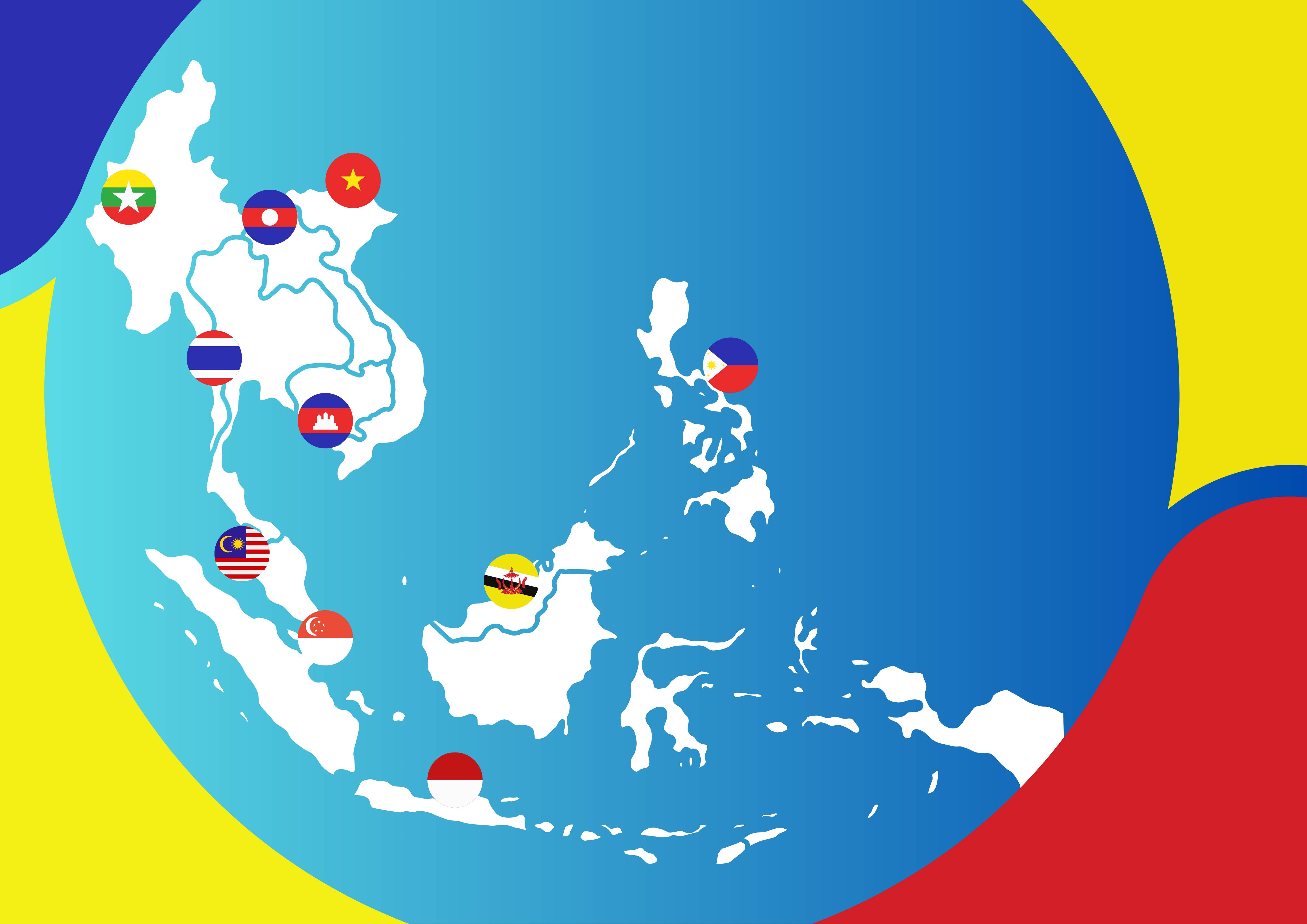
Background
The circular economy has become increasingly important for ASEAN as the region seeks to decouple economic growth from environmental impacts. The rich cultural, social, economic, and environmental diversity within ASEAN has led each member state to develop its own distinct interpretation and implementation of circular economy principles. These interpretations are influenced by local practices, cultural beliefs, and the unique challenges and opportunities of each country. Despite these differences, common values such as shared resources and responsibilities, respect for nature, and resourcefulness drive various circularity practices across the region. These diverse approaches underscore how the circular economy is being localized in ASEAN, shaped by regional cultural values and traditions, allowing each country to adapt circular economy principles to its specific context.
 Key Takeaways
Key Takeaways
These key takeaways from the webinar offer a comprehensive overview of the influence of local values on the interpretation of Circular Economy:
- Diverse Forms of Cultural Capital: Culture can manifest as tangible built heritage, intangible cultural heritage, or new creations. UNESCO’s recognition of these forms, particularly through awards and conservation efforts, underscores the importance of preserving cultural assets for sustainable community development.
- Reinterpretation of 'Economy': Traditionally, the term 'economy' is rooted in ecological balance and careful resource management. ASEAN countries are encouraged to reinterpret the circular economy to align with their ecological and cultural contexts, emphasizing sustainable household and community management.
- Cultural and Social Dimensions of Circular Economy: Integrating cultural and social values into circular economy practices is crucial for long-term success. ASEAN countries are exploring how to embed these values into the circular economy, moving beyond technology-based solutions to include community-driven approaches.
- Rediscovery of Traditional Wisdom: The concept of the circular economy is being reconnected with ancient practices, heritage, and cultural values, reframing it in a culturally relevant way and avoiding the perception of being Eurocentric.
- Promotion of Local Products and Solutions: There is a need to shift mindsets towards valuing indigenous technologies, products, and solutions over commercial alternatives to foster a circular economy that is both sustainable and culturally rooted.
- Traditional Wisdom in Climate Action: Indigenous knowledge and traditional practices are invaluable in addressing climate change and conserving natural resources. Involving ethnic communities showcases the potential of combining traditional knowledge with modern technology for environmental conservation.
- Policy Advocacy, Networking, and Cross-border Collaboration: Achieving a viable circular economy in ASEAN requires strong policy advocacy and the creation of networks that connect local, national, and regional efforts. ASEAN countries must collaborate to address shared challenges, such as cross-border issues like waste management.
- Grassroots and Gender Empowerment: A bottom-up approach is crucial for advancing circular economy practices from the ground up. Empowering women and promoting gender equality are also seen as vital components of this process.
- Public Engagement Through Storytelling: By connecting the concept of the circular economy to tangible issues like climate change and plastic waste, it becomes more relatable and actionable for the general population.
Introduction
The circular economy has become increasingly important for ASEAN as the region intensifies efforts to decouple economic growth from environmental impacts. As a region of vibrant and boundless diversity, ASEAN encompasses the distinct cultural, social, economic, and environmental landscapes of its 10 Member States—each with unique histories, ethnicities, religions, and traditions, as well as individualized geographical, political, and economic contexts. This diversity has led to various interpretations of the circular economy as the concept is localized through national practices. These interpretations are shaped by the specific context of business, communities, and civil society, as well as Southeast Asian values, cultural belief systems, and the unique challenges and opportunities of each country.
In Thailand, for instance, the circular economy is often reflected through the Sufficiency Economy, a local philosophy based on the principles of moderation, prudence, and social immunity, using knowledge and virtue to live independently and with contentment. Rooted in Theravada Buddhism, this philosophy aligns with circular economy principles by recognizing resource limitations and promoting sustainable practices that reduce resource extraction and mitigate environmental impacts such as pollution, waste generation, and nature degradation.
Similarly, in Vietnam, the values of Tích trữ (Thrift) and Trân trọng thiên nhiên (Respect for Nature) support the adoption of the circular economy. Tích trữ emphasizes making the most of available resources by extending the lifecycle of goods through durable consumption, reducing replacements, repairing products, minimizing waste, and reusing materials and second-hand products. Trân trọng thiên nhiên, which values the natural environment and resources as essential to life, promotes environmental stewardship, natural resource conservation, and biodiversity protection by fostering a sense of responsibility.
In the Philippines, related values such as Kapwa (shared responsibility), Diskarte (resourcefulness), Paggalang (respect for others), Kalikasan (nature and the world), and Utang na loob (gratitude and reciprocity) align with the circular economy. Kapwa emphasizes community and collective action, while Diskarte encourages creativity and innovation in maximizing resource use, minimizing waste, and finding new purposes for discarded materials. Paggalang promotes ethical behaviour, consideration for others, and avoiding harm to the community. Kalikasan fosters a deep respect for the environment, driving efforts to protect natural resources and reduce environmental impacts. Utang na loob instils a sense of responsibility to give back and maintain balance.
In Indonesia, Malaysia, and Singapore, the Gotong Royong tradition plays a similar role. In Javanese, Gotong means "shared burden," and Royong means "communally," together translating to mutual cooperation toward a shared goal. Gotong Royong instils a sense of individual responsibility toward society, promoting and reciprocating communal work. This tradition often involves activities such as cleaning, sweeping, picking up garbage, or cleaning drainage, but it can also extend to farming labour, clearing fields, construction, and contributing to large celebrations. Gotong Royong encourages a sharing economy by promoting the sharing of skills, labour, and resources, as well as sustainable agriculture, local food production, waste management, community resilience, and reduced dependency—core principles of the circular economy.
These are just a few examples of how the circular economy concept can be further localized and translated into practical implementations through the lens of ASEAN’s unique contexts and values. The 1.5-hour webinar titled "Localising the Circular Economy Concept under ASEAN Values," hosted by the ASEAN Circular Economy Stakeholder Platform (ACESP) and co-hosted by the EU SWITCH-Asia Policy Support Component, showcased examples from various countries in the region. The webinar compared similarities and differences in circular economy approaches among countries and explored how ASEAN values can complement and support the achievement of a circular economy.
 Chirachai Punkrasin, Executive Director of the ASEAN Centre for Sustainable Development Studies and Dialogue (ACSDSD), provided insights into the importance of social and cultural influences on circularity. He emphasized that ASEAN values, passed down through generations, remain relevant today and are compatible with current circular economy concepts and principles. These values can therefore be translated into circularity practices within local and community contexts.
Chirachai Punkrasin, Executive Director of the ASEAN Centre for Sustainable Development Studies and Dialogue (ACSDSD), provided insights into the importance of social and cultural influences on circularity. He emphasized that ASEAN values, passed down through generations, remain relevant today and are compatible with current circular economy concepts and principles. These values can therefore be translated into circularity practices within local and community contexts.
Treesuvit Arriyavat, Project Manager at the ASEAN Circular Economy Stakeholder Platform, introduced both the ASEAN Centre for Sustainable Development Studies and Dialogue (ACSDSD) and the ASEAN Circular Economy Stakeholder Platform (ACESP). Established in 2019 as part of ASEAN leaders’ commitment to sustainable development cooperation, ACSDSD is funded by the Ministry of Foreign Affairs of the Kingdom of Thailand. The centre operates as a regional catalyst for sustainable development, promoting complementarity between the SDGs and ASEAN goals. It provides intellectual leadership to circular economy and sustainable development stakeholders in the region, empowering ASEAN scholars through research studies, scholarships, and youth camp programmes. Additionally, the centre engages with regional dialogue partners through the ACESP, a regional knowledge hub on the circular economy, which organizes events and webinars on themes relevant to the circular economy.
National and regional circular economy practitioners convened to discuss the significance of local values and their impact on sustainability, circularity behaviour, policy, and national development.
This expert discussion culminated in five key questions that needed addressing:
- What role do cultural and social values play in redefining the concept of the circular economy in ASEAN?
- How can these values be leveraged to foster equitable and just economic models?
- How can ASEAN countries effectively integrate intangible cultural heritage and traditional wisdom into modern circular economy practices?
- In what ways can education systems in ASEAN embed circular economy principles to empower future generations with culturally relevant knowledge and practices?
- How can regional collaboration and policy advocacy in ASEAN strengthen the promotion of circular economy framework?
The Role of Culture and Local Values on Sustainable Development and SDGs
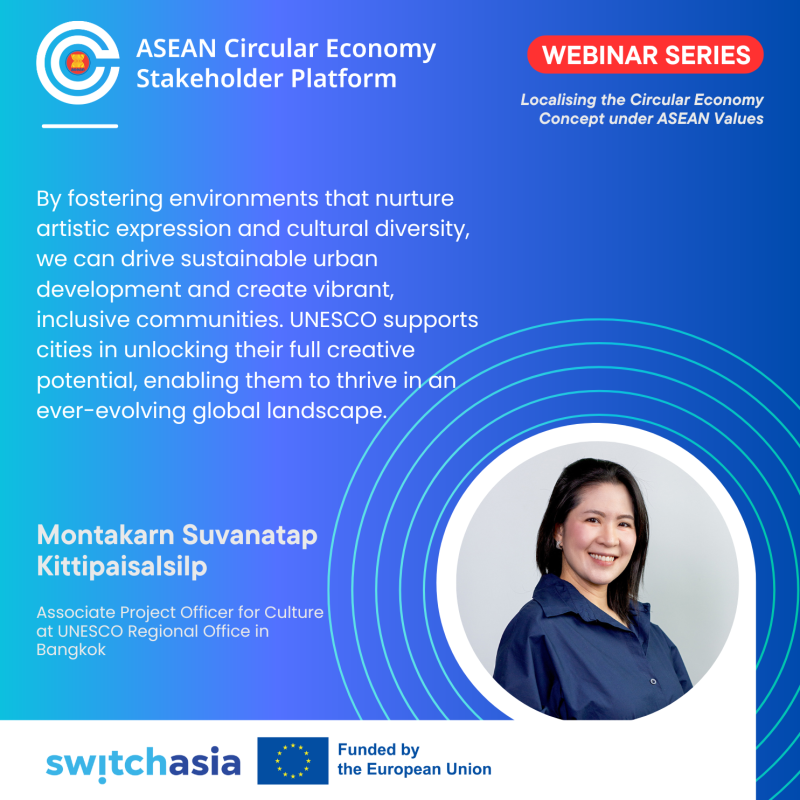 Montakarn Suvanatap Kittipaisalsilp, Associate Project Officer for Culture at the United Nations Educational, Scientific and Cultural Organisation (UNESCO) Regional Office in Bangkok, explained that culture manifests in diverse forms, serving as society’s assets or cultural capital, including heritage sites and museum artifacts (tangible built heritage), living heritage (intangible cultural heritage), and new creations. UNESCO recognizes built heritage through the UNESCO Asia Pacific Awards for Cultural Heritage Conservation, which has acknowledged over 230 restoration projects in 25 countries, contributing to cultural conservation for over two decades. The awards emphasize the importance of public, private, and community partnerships for peace, sustainable communities, and bottom-up solutions for better livelihoods.
Montakarn Suvanatap Kittipaisalsilp, Associate Project Officer for Culture at the United Nations Educational, Scientific and Cultural Organisation (UNESCO) Regional Office in Bangkok, explained that culture manifests in diverse forms, serving as society’s assets or cultural capital, including heritage sites and museum artifacts (tangible built heritage), living heritage (intangible cultural heritage), and new creations. UNESCO recognizes built heritage through the UNESCO Asia Pacific Awards for Cultural Heritage Conservation, which has acknowledged over 230 restoration projects in 25 countries, contributing to cultural conservation for over two decades. The awards emphasize the importance of public, private, and community partnerships for peace, sustainable communities, and bottom-up solutions for better livelihoods.
Intangible Cultural Heritage (ICH) encompasses “practices, representations, expressions, knowledge, skills—as well as the instruments, objects, artifacts, and cultural spaces associated with them—that communities, groups, and, in some cases, individuals recognize as part of their cultural heritage.” UNESCO’s work in promoting living heritage and how ICH contributes to sustainable development includes providing quality education through cultural know-how, offering indigenous knowledge for ecological and environmental conservation, and training in traditional building skills for monumental restorations.
UNESCO has gathered leading examples of how teachers around the world use local cultures, knowledge, and skills as learning tools and teaching materials. In Pakistan, for example, teachers use traditional textile patterns to teach geometry. In Vietnam, students learn about oscillation systems in physics through traditional Muong gongs. In Palau, where cars have only been used for a generation, students understand the concept of road safety through the traditional Pulapese customs of generosity, respect, humility, and loyalty, helping the younger generation grasp the rationale behind giving way on the road. Based on these examples, UNESCO published a practical handbook for teachers, which has been used in various ASEAN countries, including Thailand, Laos, Cambodia, and Myanmar. The use of these contextualized learning materials rooted in local culture has led to better student engagement by connecting lessons with familiar aspects of everyday life.
Moreover, the traditional wisdom and skills of ethnic minorities and indigenous peoples can play a crucial role in addressing climate change and natural resource depletion. A project currently being implemented in northern and southern Thailand involves seven ethnic communities and aims to build community researchers. This project leverages intuitive knowledge for detecting and monitoring wildlife and plants in protected areas, from forests to marine reserves. Biological science and GIS technology are being used to help interpret and communicate ethnic knowledge to the public, fostering a broader understanding of how humans can coexist harmoniously with nature.
UNESCO’s global programme on the Creative Cities Network utilizes cultural and creative resources for sustainable and resilient urban development. The programme aims to enhance access to culture and leverage the power of creativity for urban resilience and development by strengthening society, environment, economy, and governance. A Creative City is one that harnesses the power of human intelligence and creativity within its boundaries to become more resilient to future crises or changes. The programme has gained popularity due to its benefits for tourism and national pride. As a result, there are now 246 Creative Cities worldwide, including in Cambodia, Indonesia, Malaysia, the Philippines, Vietnam, and Thailand. Currently, Thailand boasts seven Creative Cities, which are at the forefront of the country’s new soft power action plan aimed at driving economic growth through cultural assets.
Reflecting ASEAN Values on Circular Economy
 In this session, Imelda Bacudo, Climate Finance & Engagement Strategist at the Food and Agriculture Organisation (FAO) elaborated on how cultural values are reflected in climate actions. Southeast Asia is a region known for its love of food, but it also faces significant challenges due to the impacts of climate change on food security. More than half of the world’s population affected by hunger is in Asia. Despite innovations and technologies aimed at alleviating food insecurity, issues like undernourishment and micronutrient deficiencies persist. The primary drivers of food insecurity are linked to climate change, including extreme weather events, droughts, floods, increased salinity, and extreme temperatures. This underscores the urgent need for climate actions to achieve a circular economy. The Paris Agreement aims to limit global warming to 1.5 degrees Celsius, as the current trajectory of a 2.4-degree increase is simply too dangerous. Failure to meet the 1.5-degree target could lead to catastrophic consequences, including the potential extinction of species.
In this session, Imelda Bacudo, Climate Finance & Engagement Strategist at the Food and Agriculture Organisation (FAO) elaborated on how cultural values are reflected in climate actions. Southeast Asia is a region known for its love of food, but it also faces significant challenges due to the impacts of climate change on food security. More than half of the world’s population affected by hunger is in Asia. Despite innovations and technologies aimed at alleviating food insecurity, issues like undernourishment and micronutrient deficiencies persist. The primary drivers of food insecurity are linked to climate change, including extreme weather events, droughts, floods, increased salinity, and extreme temperatures. This underscores the urgent need for climate actions to achieve a circular economy. The Paris Agreement aims to limit global warming to 1.5 degrees Celsius, as the current trajectory of a 2.4-degree increase is simply too dangerous. Failure to meet the 1.5-degree target could lead to catastrophic consequences, including the potential extinction of species.
ASEAN’s 2050 vision seeks to achieve food security through sustainability and the circular economy, aiming to provide sustainable and healthy food for all. An integrated approach—strengthening policy, providing financial support, raising awareness of climate change impacts, scaling up scientific sharing, building knowledge, incentivizing innovation, and ensuring coordination—is key to achieving this vision. Recently, ASEAN validated a goal of carbon-neutral agriculture by 2050, with the first strategy being a shift in dietary habits. While diet shifts, such as promoting vegetarianism, are common trends in Europe, a dialogue is needed to define what diet shift means for ASEAN. Another important strategy is reducing food loss and waste to limit methane emissions from our food system. In achieving these goals, cultural values play a significant role.
In the Philippines, the concept of "Mabubusong" reflects the idea of receiving what one deserves. Imelda Bacudo recalls her mother’s saying: “If you don't finish your rice, you will be Mabubusong—your hands will stick together; you have to finish everything.” In a sense, the principles of the circular economy and climate action are deeply ingrained in our culture: eating every grain of rice, utilizing every part of livestock, and consuming all parts of a fish before turning it over. These cultural practices inherently support the reduction of greenhouse gas emissions by minimizing food waste, as Bacudo explained.
Local knowledge also plays a crucial role, such as predicting rainfall by observing cloud formations around mountain tops or utilizing the Subak system in Bali, Indonesia—a communal water management system. Many initiatives and climate information services promote local knowledge and work with agro-meteorological services to localize climate information and predict extreme weather events that severely impact agricultural crops. In times of hardship, such as when one village suffers, the neighbouring village steps up to help. This tradition is why ASEAN endorsed the ASEAN Plus Three Emergency Rice Reserve Agreement, particularly for emergencies and during the pandemic.
ASEAN is a region built not on individualism, but on communities working together. At COP28 in the United Arab Emirates, farmers were placed at the centre of the stage as 160 heads of state, including ASEAN leaders, signed a declaration on sustainable agriculture, resilient food systems, and climate action. The diverse values across ASEAN, from Thailand’s Sufficiency Economy and Indonesia’s Gotong Royong to the Philippines’ Pakikisama (being one with each other) and Bayanihan (spirit of communal unity and cooperation) and Vietnam’s Respect for Nature, are rooted not in individualism but in collective community effort. We think, feel, and act as a community. This is the same principle underlying the circular economy, where everyone and everything are interconnected.
Panel Discussion: ASEAN Values on the Interpretation of Circular Economy
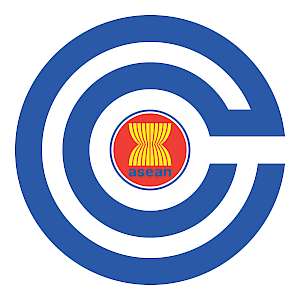
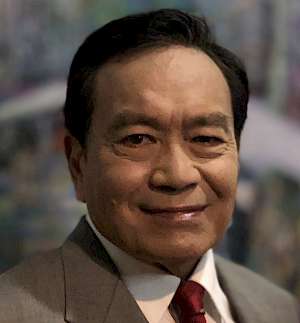 Anthony Pramualratana moderated the session on local interpretation and implementation of the circular economy, joined by panellists from Laos PDR, Malaysia, the Philippines, Thailand, and Vietnam.
Anthony Pramualratana moderated the session on local interpretation and implementation of the circular economy, joined by panellists from Laos PDR, Malaysia, the Philippines, Thailand, and Vietnam.
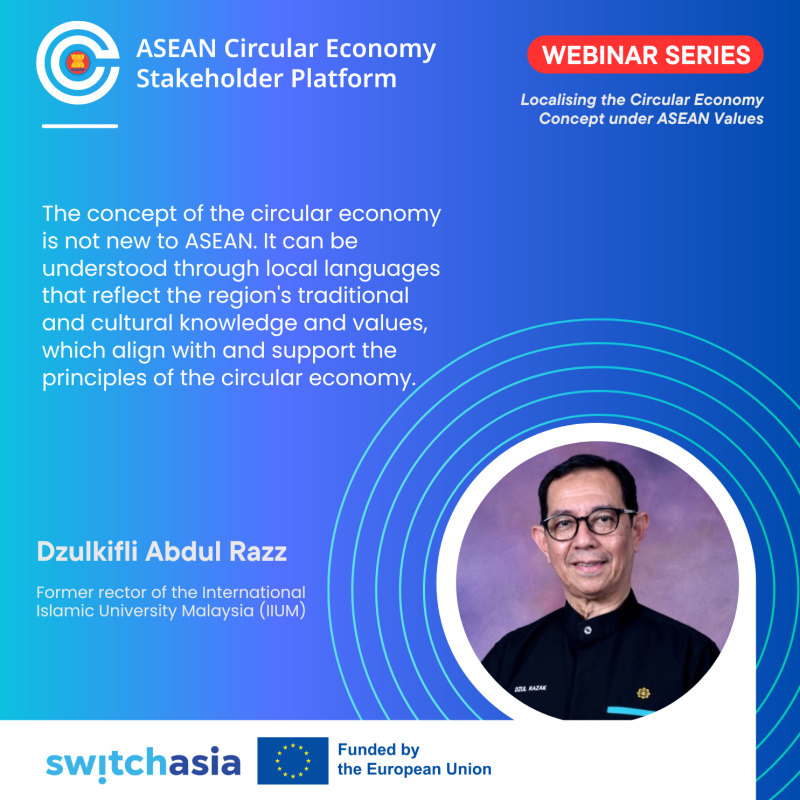 Professor Emeritus Tan Sri Dato Dsulkifli Abdul Razak, Former Rector of the International Islamic University Malaysia (IIUM),) reflected on the Subak system, noting that it has been around for more than 900 years. He pointed out that the idea of the circular economy has existed for a long time but has been lost over the years. In Malaysia, local wisdoms like this are being rediscovered and restored, with related terminology being identified. He explained that if we continue to use the term ‘circular economy,’ progress may be difficult because it is often viewed as a Eurocentric concept. The traditional word, "Sajakra," associated with Gotong Royong, means balance, harmony, and sharing. He emphasized that we must consider the economy not only from a monetary perspective but also from the perspective of values. Important values like compassion, empathy, and sympathy resonate with an economic understanding that is not just quantifiable but also intangible. These are the values that he believes drive the circular economy because it is necessary for us to act to alleviate the suffering of others. We aspire to be prosperous, but not at the expense of others; we want everyone to prosper as well. Fundamentally, it is about how we can live together in equity, justice, and fairness.
Professor Emeritus Tan Sri Dato Dsulkifli Abdul Razak, Former Rector of the International Islamic University Malaysia (IIUM),) reflected on the Subak system, noting that it has been around for more than 900 years. He pointed out that the idea of the circular economy has existed for a long time but has been lost over the years. In Malaysia, local wisdoms like this are being rediscovered and restored, with related terminology being identified. He explained that if we continue to use the term ‘circular economy,’ progress may be difficult because it is often viewed as a Eurocentric concept. The traditional word, "Sajakra," associated with Gotong Royong, means balance, harmony, and sharing. He emphasized that we must consider the economy not only from a monetary perspective but also from the perspective of values. Important values like compassion, empathy, and sympathy resonate with an economic understanding that is not just quantifiable but also intangible. These are the values that he believes drive the circular economy because it is necessary for us to act to alleviate the suffering of others. We aspire to be prosperous, but not at the expense of others; we want everyone to prosper as well. Fundamentally, it is about how we can live together in equity, justice, and fairness.
He further elaborated on the meaning of the word ‘economy.’ The word ‘eco-nomy’ combines ‘eco,’ which implies something ecological, balanced, and nature-oriented, and ‘nomy,’ which refers to an area of knowledge or a law governing eco. Thus, the economy truly means the careful management of available resources, rather than what it is currently understood to be. Traditionally, the origin of the word ‘economy’ is from the Greek word ‘oikonomia,’ which means household management. We must find creative ways of interpreting the circular economy locally, allowing traditional values to play a role organically, rather than forcing them into an imposed idea of the economy. He cited the publication “Delivering Compassion: 41 Case Studies Experiences from SASMEC @IIUM," which discusses how compassion can be embedded in economic activities. Compassion, he noted, becomes a significant discussion point when considering how to integrate it into the circular economy from a values perspective.
For example, he explained that bananas produce fruit only once, and then the tree is typically discarded. The banana peel is also discarded after consumption. However, an innovation has emerged to process banana peels into flour, which is more nutritious than other flours on the market. This flour can be processed into noodles and other food products. Additionally, the banana tree trunk can be converted into paper, which is 40 times stronger than conventional paper and popular in Japan for ornamental purposes. The banana leaves can be used for wrappers and containers. Through this approach, the entire banana tree is "circularized" by utilizing all its parts. This economic values concept is being integrated into the curriculum, where students work with communities to understand the circular economy from a traditional perspective and embed it into the future for sustainability.
Professor Razak also emphasized the need to revise the concept of consumerism. In Malaysia’s context, defining the term "Sajatra" (basic requirement) is crucial. People can have what they want, provided everyone has already attained the minimum required standards. This minimum standard can be understood within the context of Sajatra, which everyone should aspire to. He linked the idea of Artificial Intelligence (AI) to consumerism, noting that AI algorithms are often utilized and imported without consideration of whether they align with local traditions, meet local standards, or reflect local values. One of the ongoing projects at IIUM is to identify the local values that need to be incorporated into AI algorithms so that conclusions are more balanced and not solely based on one region. He acknowledged that while many do not fully understand the technology, it is pervasive in the education system, and we must decide where the future of education belongs.
He also discussed how ASEAN indigenous ideas have common values. Once connected, these values become very strong and can be embraced by ASEAN as a whole. From there, the concept can expand into Asia, finding other common values, such as "Ikigai" (a reason to live) from Japan. Further connections can be made with other regions, like "Ubuntu" (I am because you are) from Africa. Although these concepts are geographically compartmentalized, they all speak to the same human heritage, just with different pronunciations. Therefore, a bottom-up approach is essential to respect indigenous ideas. Education is also a critical element in raising awareness. Once people are aware, it becomes easier to use local terminology rather than imported terms. While religion can sometimes create challenges, the values of spirituality are almost universal and consistent across all religions. Creating justice, fairness, and equity around the world begins with each of us.
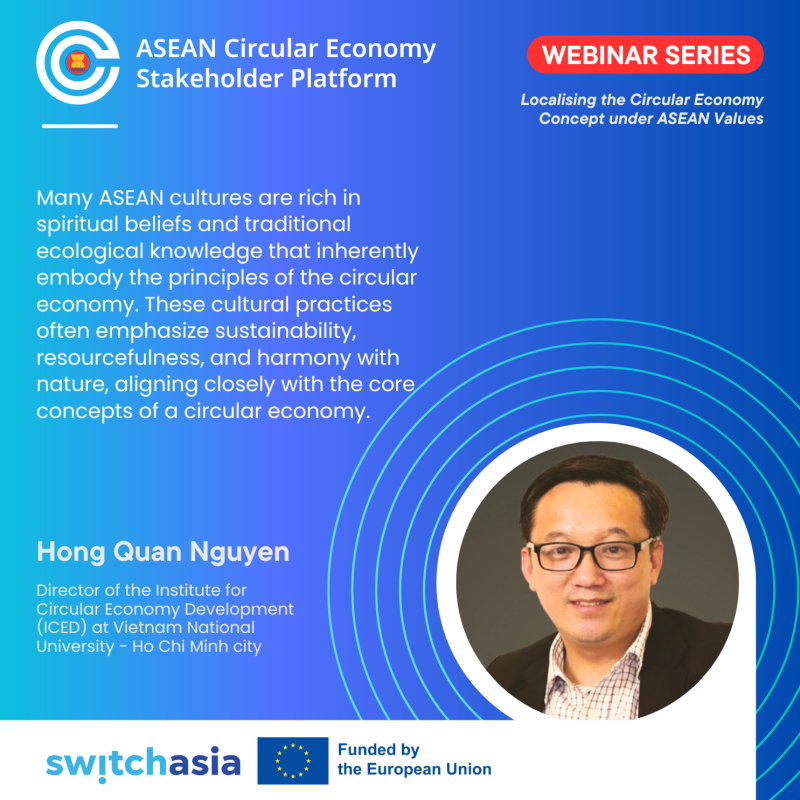 Nguyen Hong Quan, Director of the Institute for Circular Economy Development (ICED) at Vietnam National University - Ho Chi Minh City, presented popular circularity activities in Vietnam. He noted that in the past, recycling activities were the main focus, leading to a well-developed recycling industry across various sectors, including plastic, electronics, and agriculture. One popular model in rural Vietnam is the VAC system—vuon, ao, chuong, or garden, pond, livestock system—an integrated approach to traditional farming for family food production. These three cycles or components are linked together and have been referred to as a circular economy in the Vietnamese context. However, circular economy has now become a top agenda item toward sustainability and green roadmaps. It is considered the new economic model for Vietnam and is a top political priority.
Nguyen Hong Quan, Director of the Institute for Circular Economy Development (ICED) at Vietnam National University - Ho Chi Minh City, presented popular circularity activities in Vietnam. He noted that in the past, recycling activities were the main focus, leading to a well-developed recycling industry across various sectors, including plastic, electronics, and agriculture. One popular model in rural Vietnam is the VAC system—vuon, ao, chuong, or garden, pond, livestock system—an integrated approach to traditional farming for family food production. These three cycles or components are linked together and have been referred to as a circular economy in the Vietnamese context. However, circular economy has now become a top agenda item toward sustainability and green roadmaps. It is considered the new economic model for Vietnam and is a top political priority.
He explained that the Circular Economy Plan and the upcoming National Action Plan are being developed to support various sectors and industries. The objectives are aligned with the National Carbon Neutrality Plan and support green growth or green transition programmes, sustainable consumption and production, climate change adaptation and mitigation, and inclusive development. Circular economy is being mainstreamed in socioeconomic development plans at both national and local levels. However, the challenges lie in addressing institutional barriers before discussing cross-sectoral topics. The government is currently awaiting a new decree from the prime minister on the regulatory sandbox for implementing circular economy. Various capacity-building, awareness-raising, and education programmes are being developed to help different industries and the general public understand the circular economy and the direction from the central government.
Quan recalled reading a paper a few years ago on the historical development of the circular economy worldwide, which was largely influenced by Western knowledge and science. However, one section of the paper discussed the linkages between circular economy and Tao Buddhism. He believes that linking circular economy to religion is a good idea because it helps connect people and supports collaborative efforts. He emphasized that it is our role to bring society together to implement the circular economy. The cultural and social values, particularly from Southeast Asian countries, provide a wealth of knowledge that can be shared and integrated into the concept of circular economy, beyond just technology-based solutions. He stressed that the social aspects must be considered in the coming years.
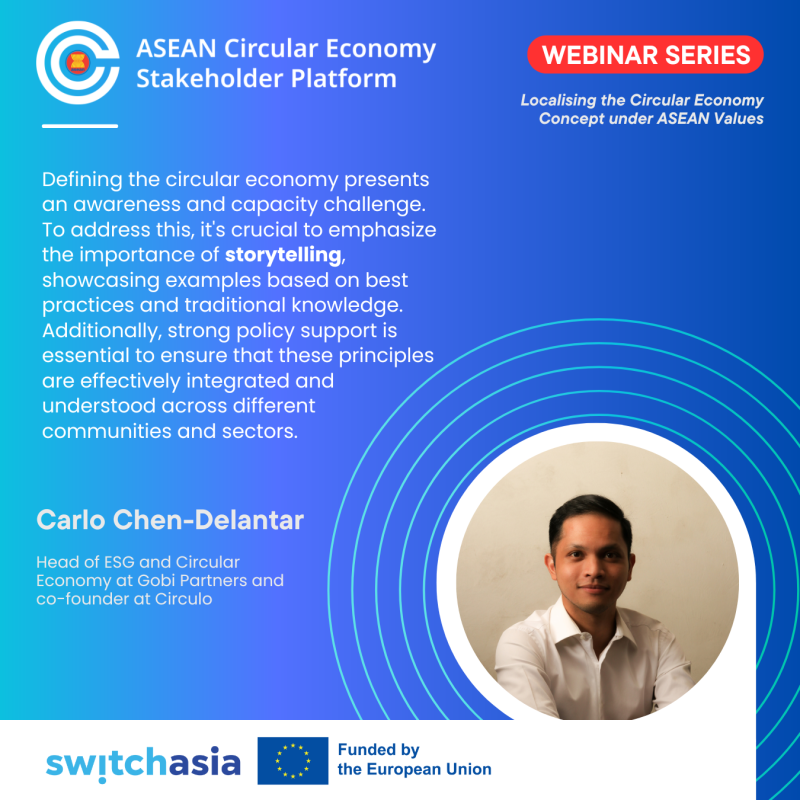 Carlo Chen-Delantar, Co-founder and Partner of Gobi-Core Philippines Fund, agreed that circular economy is a relatively new term, and we are still learning what sustainability means through various frameworks. He acknowledged that identifying a harmonized definition of circular economy can be challenging for any country. In the Philippines, storytelling and reflecting on past events are always helpful. The focus can be on a pain point or examples that resonate with the audience or demographic. The best example, he noted, is climate change, illustrated by the deadly Super Typhoon Yolanda and the more recent Super Typhoon Carina, which flooded parts of Metro Manila up to the second-floor ceiling. The first thing visible during the flood was floating plastics, leading to the question: who will tackle plastic waste? Thus, the circular economy conversation must begin with understanding what circular economy is and how it differs from the current linear economy.
Carlo Chen-Delantar, Co-founder and Partner of Gobi-Core Philippines Fund, agreed that circular economy is a relatively new term, and we are still learning what sustainability means through various frameworks. He acknowledged that identifying a harmonized definition of circular economy can be challenging for any country. In the Philippines, storytelling and reflecting on past events are always helpful. The focus can be on a pain point or examples that resonate with the audience or demographic. The best example, he noted, is climate change, illustrated by the deadly Super Typhoon Yolanda and the more recent Super Typhoon Carina, which flooded parts of Metro Manila up to the second-floor ceiling. The first thing visible during the flood was floating plastics, leading to the question: who will tackle plastic waste? Thus, the circular economy conversation must begin with understanding what circular economy is and how it differs from the current linear economy.
In their circularity advocacy work, Chen-Delantar emphasized the importance of being proactive in responding to new circular policies and regulations. He urged consideration of the differences between general terms of sustainability and circular economy and what circular economy means for each industry. Discussing taxonomies and examples of waste in different sectors—food, electronics, plastics, wastewater, energy, and others—can help industries define their circular economy framework. In the Philippines, there are many laws like the Extended Producer Responsibility (EPR) and the Solid Waste Management Act, which are both technically part of the circular economy. Congress is now set to pass a Circular Economy Bill, which will serve as the foundational framework for all industries to follow.
He noted that on one end, it is crucial to capture people’s imaginations, simplifying concepts to connect with pain points, and then create a compelling narrative around circular economy. On the other end, there are corporate requirements through policies and mandates. Both ends must move forward in the right direction. The only thing left, he stated, is for practitioners to build a bridge connecting both ends.
Outside of generative AI, the majority of investments have been in climate tech. In terms of circular economy, most investments are in marketplaces, plastics, mobility, and electronics. He noted that we have already surpassed conservative estimates for adopting renewables and electric vehicles (EVs) because people realize it is possible. Industries now want to create new frameworks to incentivize further action, but this also requires policies to work hand in hand, bridging the gap. He emphasized the importance of creating new innovations, as many technologies are already available in different parts of ASEAN. For example, the Philippines and Indonesia are strong in food waste and plastics, Thailand excels in textile technology, and Vietnam focuses on EV storage and battery systems. Now, it is time to increase the adoption rate. The demand is there, but the supply is missing.
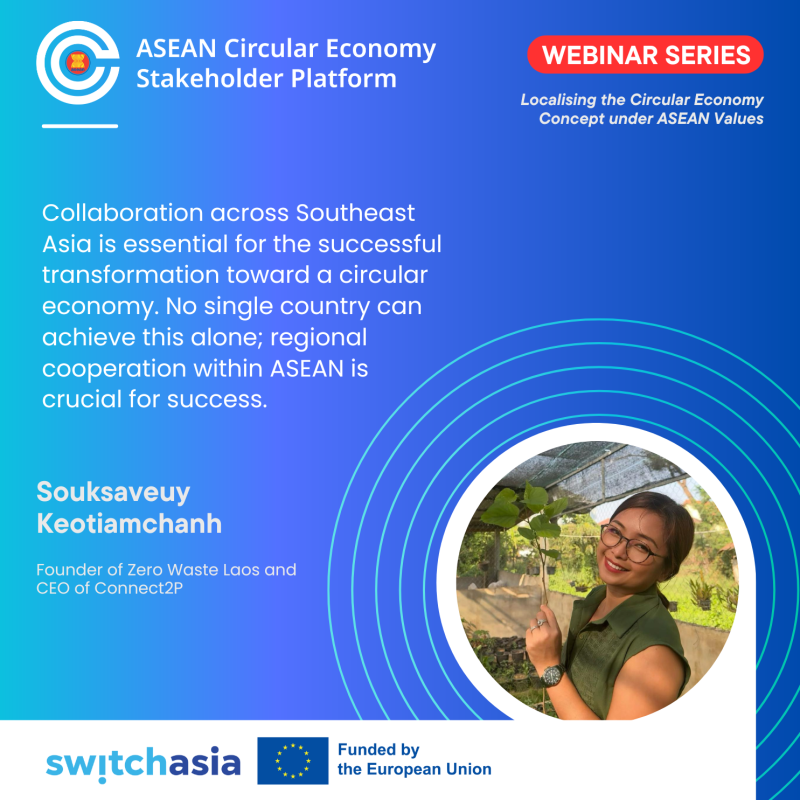 Souksaveuy Keotiamchanh, Founder of Zero Waste Laos and CEO of Connect2P, shared that her work is on the ground and connects with grassroots communities and young generations. She noted that Lao PDR has similar circular practices to other countries in ASEAN. Common practices focus on repairing, sharing, and growing their own food. However, she emphasized that elevating these practices to the policy level requires more awareness and effort. Circular economy is not just about the concept but also about the available facilities. For example, waste management in ASEAN countries involves significant cross-border trade. Lao PDR is primarily a consumer country, while others may be both consumers and producers. Products and waste, such as electronic and plastic waste, are traded across borders. Therefore, circular economy is not confined to one country; collaborative efforts at the ASEAN level and beyond are essential. She stressed that local values and practices on the ground can help elevate the concept into policy, but no single country can tackle the circular economy alone.
Souksaveuy Keotiamchanh, Founder of Zero Waste Laos and CEO of Connect2P, shared that her work is on the ground and connects with grassroots communities and young generations. She noted that Lao PDR has similar circular practices to other countries in ASEAN. Common practices focus on repairing, sharing, and growing their own food. However, she emphasized that elevating these practices to the policy level requires more awareness and effort. Circular economy is not just about the concept but also about the available facilities. For example, waste management in ASEAN countries involves significant cross-border trade. Lao PDR is primarily a consumer country, while others may be both consumers and producers. Products and waste, such as electronic and plastic waste, are traded across borders. Therefore, circular economy is not confined to one country; collaborative efforts at the ASEAN level and beyond are essential. She stressed that local values and practices on the ground can help elevate the concept into policy, but no single country can tackle the circular economy alone.
Moreover, she highlighted the strong role gender equality and female empowerment can play in achieving a circular economy if given the opportunities. The challenge in promoting local products, she noted, is the lack of incentives. She called for comprehensive policies to incentivize local products and disincentivize imported ones.
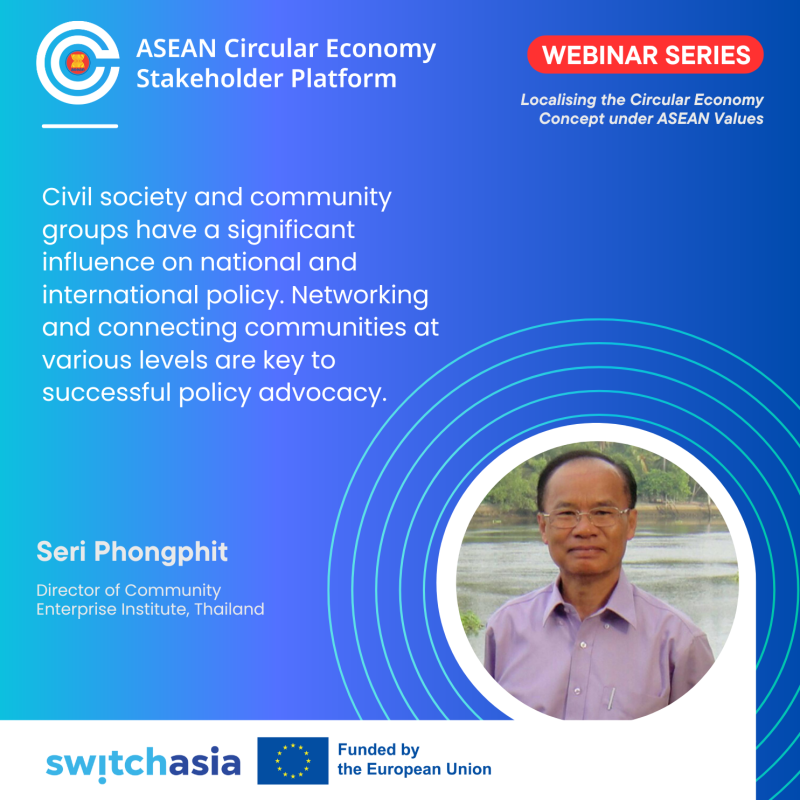 Seri Phongphit, Director of the Community Enterprise Institute, traced the origin of Thailand’s Sufficiency Economy Theory to a chapter in the book "Small is Beautiful" by German-born British economist E. F. Schumacher, who became intrigued with Buddhism while consulting for the Burmese government and learned about Buddhist Economy. This book, which calls for the end of excessive consumption, includes a chapter on Buddhist Philosophy. The late King Rama IX translated this chapter into Thai, which largely inspired the conception of the Sufficiency Economy.
Seri Phongphit, Director of the Community Enterprise Institute, traced the origin of Thailand’s Sufficiency Economy Theory to a chapter in the book "Small is Beautiful" by German-born British economist E. F. Schumacher, who became intrigued with Buddhism while consulting for the Burmese government and learned about Buddhist Economy. This book, which calls for the end of excessive consumption, includes a chapter on Buddhist Philosophy. The late King Rama IX translated this chapter into Thai, which largely inspired the conception of the Sufficiency Economy.
Phongphit shared that two actions are necessary to make the circular economy viable and realistic in society. The first is policy advocacy, as current governmental policies are inadequate. Three principles stand out in achieving the SDGs: a bottom-up approach, human dignity, and sufficiency economy. He emphasized the need for people to be linked together, networking not only at the community or provincial level but also at the national, regional, and international levels. Drawing from his experience working with the Village Foundation on HIV, he shared that Europe also started from its own communities after World War II, then progressed to organizational, provincial, national, and regional levels. They encouraged him to apply the same approach at the ASEAN level by starting from the bottom and moving up. He concluded that this is what we need to do for the circular economy and sustainable development. Networking activities to facilitate sharing best practices and key learnings at all levels are crucial for this transformation journey.
- Video recording available here
- Event info at ASEAN Circular Economy Stakeholder Platform and EU SWITCH-Asia
Acknowledgment
This Knowledge Brief was prepared by Dr. Sirasa Kantaratakul, the EU SWITCH-Asia Policy Support Component (PSC) and the ASEAN Circular Economy Stakeholder Platform. The information and contents in this document are the sole responsibility of the authors and do not necessarily reflect the views of the European Union.



